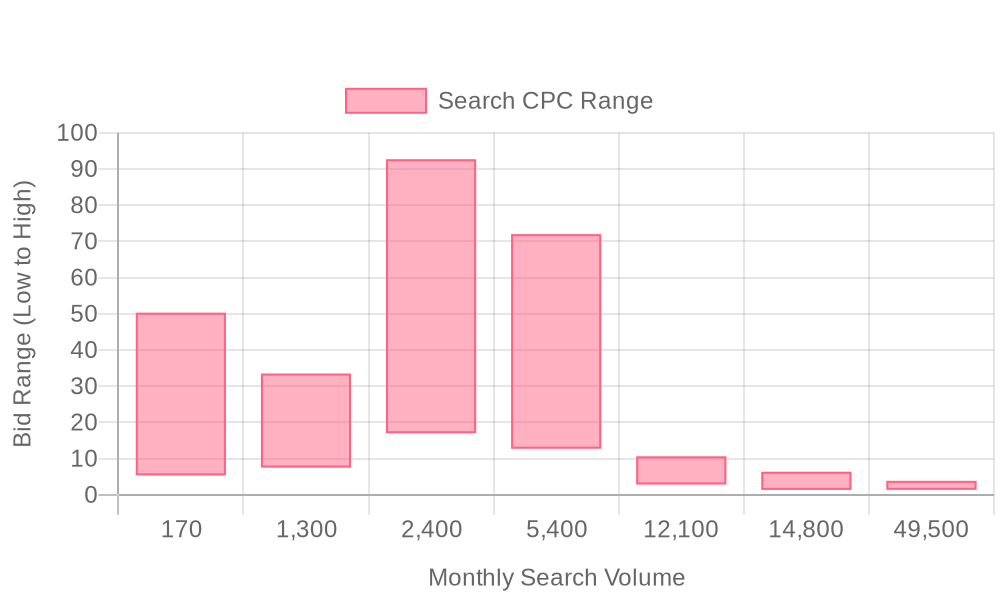
Supercharge your lead generation with a FREE Google Ads audit - no strings attached! See how you can generate more and higher quality leads
Get My Free Google Ads AuditFree consultation

No commitment
Supercharge your lead generation with a FREE Google Ads audit - no strings attached! See how you can generate more and higher quality leads
Get My Free Google Ads AuditFree consultation

No commitment
In today's complex marketing landscape, employee benefits insurance providers face the challenge of effectively bridging online and offline channels to attract decision-makers. Missing high-value prospects because they aren’t tracked in CRM systems can lead to lost opportunities. Advanced tools now enable businesses to capture these decision-makers precisely when they're searching for solutions by tracking online behavior and correlating it with offline interactions. With Google Ads, businesses can identify anonymous visitors who express real intent and integrate them into customer match lists to optimize ad spend toward qualified prospects. For those in employee benefits insurance, Google Ads provides the opportunity to intercept decision-makers at their moment of need and ensure informed, timely follow-ups to maximize engagement. This comprehensive guide will explore how to leverage Google Ads for maximum impact in the employee benefits insurance sector, aligning with broader marketing strategies to enhance lead generation and drive growth.
Modern B2B marketers in employee benefits insurance rely on digital channels to connect with decision-makers who control significant budgets and complex benefits portfolios. A precision-driven Google Ads strategy captures high-intent buyers in real time, ensuring marketing investment focuses on qualified prospects rather than wasted impressions. For a comprehensive playbook on maximizing ROI and campaign structure, explore this Google Ads strategy for insurance companies.
Advanced analytics and integrated platforms make it possible to identify anonymous website visitors, revealing which companies and stakeholders are engaging with your benefits content. Accurate attribution and offline conversion tracking provide a clear picture of which campaigns drive qualified leads and enrolled employees, not just clicks.
With a data-driven approach, marketers can map the entire buyer journey and segment audiences by company size, industry, and decision-making stage. Sophisticated tools enable real-time intent monitoring, allowing budget to shift instantly toward accounts demonstrating high purchase readiness for employee benefits insurance solutions. By syncing enriched audience data directly into Google Ads and CRM systems, engagement remains personalized and relevant throughout the sales funnel.
Dynamic audience segments update automatically as prospects engage with your assets or move closer to a decision. This continuous refresh ensures that remarketing efforts target only those who show genuine interest, maximizing conversion rates at each stage. Integrating online and offline touchpoints delivers unified insights, allowing teams to optimize creative, messaging, and budget allocation for sustained improvements in cost per lead and sales velocity.
The following step-by-step guide outlines how to leverage Google Ads for Employee Benefits Insurance, from keyword targeting to campaign execution, with actionable tactics designed for growth-focused B2B teams. Each section highlights practical methods to unify your marketing data, engage high-value insurance buyers, and accelerate revenue outcomes in a highly regulated market. If you're ready to see these strategies in action, get started for free with Sona.

Employee benefits insurance providers operate in an environment where decision cycles are long, competition is fierce, and buyer intent signals are fleeting. To outperform, these organizations must deliver timely, relevant outreach the moment a prospect shows interest. Empowered by modern marketing technology, teams can now identify which businesses are actively researching employee benefits solutions and immediately trigger targeted Google Ads campaigns that align with real-time demand.
With precision targeting, employee benefits insurers can leverage Google Ads to segment audiences based on company size, industry, and in-market behaviors, ensuring each impression reaches HR and finance leaders most likely to convert. Rather than relying solely on form fills or static lists, advanced platforms enable marketers to track nuanced engagement patterns—such as whitepaper downloads or benefits calculator usage—and automatically sync high-quality audience data into their CRM. For a comprehensive guide to maximizing ROI with Google Ads in the insurance industry, see this insurance company PPC strategy playbook.
Furthermore, unified data from Google Ads and CRM systems enables revenue teams to analyze which campaigns drive not only clicks, but actual policy enrollments and long-term client value. This data-driven approach offers actionable insights to shift budget toward top-performing segments, refine messaging for specific buyer personas, and optimize end-to-end campaign efficiency. By connecting these dots, employee benefits insurers can respond to market changes with agility, seize time-sensitive opportunities like open enrollment, and build a sustainable pipeline of qualified leads. To see how you can activate your own dynamic audiences and optimize your campaigns, get started for free with Sona.

Each campaign type plays a distinct role in a comprehensive employee benefits advertising strategy. By unifying intent signals, CRM data, and conversion outcomes, marketing and revenue teams can maximize the impact of every ad dollar while ensuring measurement at the account level, not just by anonymous clicks. This approach gives insurance providers the control and transparency needed to adapt quickly to market shifts and regulatory changes, ultimately driving more effective insurance lead generation and higher-value client relationships. To see how these solutions can work for your team, get started for free with Sona.

Growth in employee benefits insurance hinges on uncovering market segments that traditional insurance advertising often overlooks. Modern revenue teams see significant results by applying vertical keyword targeting to reach decision-makers in industries with high employee benefit needs, such as technology, healthcare, and education. By layering hyper-specific industry terms and job titles into keyword lists, campaigns move beyond broad health insurance advertising and instead capture precise in-market audiences that actively evaluate providers.
Competitor analysis remains a powerful lever for discovering under-served opportunities. Reviewing the ad strategies of established players reveals gaps in messaging, keyword coverage, and regional targeting. By mapping where competitors are over-indexed or absent, insurance marketers can strategically shift budgets toward unclaimed geographies or benefit categories, optimizing reach and minimizing wasted spend. This approach is further strengthened by dynamic retargeting and industry-specific placements, as outlined in this comprehensive guide to insurance company PPC strategy, which keeps brand awareness high throughout lengthy evaluation cycles while nurturing leads as they progress.
Incomplete ROI measurement is a persistent barrier for employee benefits campaigns, especially when high-value conversions occur offline through broker calls or in-person demos. Revenue teams can now close this gap by tying every lead and offline event back to its originating ad click. Advanced attribution connects sales activity, such as policy signings or renewal meetings, directly to digital touchpoints. This data-driven clarity empowers smarter budget allocation, allowing teams to double down on the channels, keywords, and creative that demonstrably drive revenue. Enriching campaign data with visitor identification and real-time intent signals also enables marketers to dynamically update audiences, ensuring outreach remains relevant as prospects engage, evaluate, and convert.

Audience segmentation in employee benefits insurance marketing transforms scattered website visits and disjointed clicks into actionable prospect intelligence. Modern revenue teams now leverage advanced segmentation to map buyer journeys and orchestrate campaigns that reach CFOs, HR leaders, and benefits decision-makers with unprecedented precision.
The most effective segmentation strategies go beyond standard demographic filters. By integrating intent signals—such as content engagement, product comparison activity, or repeat visits—marketers can dynamically update audience lists as prospects move from initial research to active evaluation. This creates a living, breathing view of the buying committee, allowing teams to prioritize outreach to accounts demonstrating strong buying signals.
Custom match lists and segment-specific ad groups further elevate targeting. For example, a group of users who downloaded a compliance checklist can be added to a dedicated audience that receives ads highlighting HR compliance support and streamlined onboarding—a message directly aligned with their expressed needs. Simultaneously, those who engaged with cost-savings calculators might be shown case studies or ROI calculators, nurturing them toward a consultation. For a comprehensive guide on creating effective Google Ads segmentation and targeting, see this playbook for insurance company PPC strategy.
Real-time data integration means audience segments adjust instantly as new information emerges. As a result, marketing budgets shift fluidly toward the most in-market accounts, ensuring spend is never wasted on disengaged or irrelevant audiences. Tightly syncing CRM systems with Google Ads ensures that as soon as a lead’s status changes—such as moving to a late-stage opportunity or becoming an active customer—ad exposure and messaging adjust automatically. Teams can use audience data integrations to automate these updates across platforms.
Sales teams benefit from this unified approach, gaining clear visibility into stakeholder engagement and intent. Instead of cold outreach, reps can prioritize follow-up with accounts showing the highest propensity to buy, using context-rich insights from recent ad interactions, website behavior, and content downloads. This alignment between marketing and sales accelerates conversion rates and shortens the often lengthy employee benefits insurance buying cycle. To see how your team can leverage these capabilities, get started for free with Sona.

| Industry | Keyword | Monthly Search Volume | Competition Level | Low Bid | High Bid |
| Employee Benefits Insurance | pie workers comp | 170 | MEDIUM | 5.4 | 50.3 |
| Employee Benefits Insurance | employee benefits insurance | 1300 | LOW | 7.55 | 33.49 |
| Employee Benefits Insurance | group health insurance for small business | 2400 | LOW | 17.04 | 92.69 |
| Employee Benefits Insurance | employee health insurance | 5400 | LOW | 12.77 | 72 |
| Employee Benefits Insurance | long term disability insurance | 12100 | LOW | 2.88 | 10.63 |
| Employee Benefits Insurance | fedvip | 14800 | LOW | 1.39 | 6.38 |
| Employee Benefits Insurance | short term disability | 49500 | LOW | 1.41 | 3.87 |
Precision targeting is the foundation of successful employee benefits insurance advertising. By focusing on high-intent keywords, marketing teams ensure every dollar spent is directed toward prospects actively seeking solutions, resulting in measurable improvements in qualified lead volume and sales pipeline velocity. Strategic keyword selection also enables brands to capture demand at every stage of the buyer journey, from broad informational research to urgent requests for group quotes. For practical guidance on building effective PPC campaigns in insurance, review this comprehensive Google Ads strategy for insurance.
The most effective campaigns use a mix of keyword types to maximize reach and relevance. Transactional keywords such as “employee benefits insurance quotes” and “group health plans for businesses” reliably attract HR leaders and decision-makers ready to engage. Informational phrases like “how to choose employee benefits for small businesses” and “compliance requirements for group health insurance” build trust with audiences in the research phase. Campaigns gain further depth by targeting competitor and comparison terms, such as “best employee benefits insurance providers” or “PPO vs HMO for companies,” intercepting buyers evaluating their options. Explore more best practices in our marketing analytics blog.
Success depends on more than keyword selection alone. Dynamic keyword lists, informed by real-time audience intent and cross-channel engagement data, allow marketers to continuously refine targeting as market conditions shift. Integrating intent signals and CRM data enables teams to identify when a previously anonymous visitor demonstrates strong buying signals, triggering personalized ad experiences and retargeting sequences. As audiences move through the funnel, these dynamically updated lists ensure messaging remains relevant and timely, resulting in higher conversion rates and improved campaign efficiency.
Advanced platforms unify keyword targeting with sales and customer data, enabling real-time audience enrichment and attribution. When a prospect’s engagement escalates—such as repeated visits to pricing pages or attendance at a compliance webinar—the system can automatically elevate their audience segment and adjust bids or creative accordingly. This synergy between keyword strategy and audience management ensures that budget is always aligned with the accounts most likely to convert, empowering employee benefits insurance marketers to deliver results with greater speed and precision. Ready to optimize your campaigns? Get started for free with Sona.
A high-performing Google Ads strategy for employee benefits insurance combines precise audience targeting, compelling messaging, and airtight conversion tracking. Marketers who unify prospect data, intent signals, and campaign analytics gain a decisive edge, enabling them to reach high-value decision makers and optimize every touchpoint in the buyer journey with precise audience intelligence.
This execution framework helps insurance revenue teams address the common challenge of untracked leads by building a closed-loop system. By following each step, teams can identify and engage qualified business prospects, craft relevant offers, and continuously refine campaigns for measurable growth. For additional strategies to unify marketing and sales data, explore integrating Sona with HubSpot CRM.
Successful campaigns begin with keyword research tailored to the actual language used by HR leaders, CFOs, and benefits administrators evaluating employee insurance products. Marketers should focus on long-tail keywords such as "group employee health plans," "business dental benefits," and "ACA-compliant employee insurance." Negative keywords must be layered in to exclude individual insurance shoppers, Medicare queries, and unrelated personal policy searches. Data-driven tools and unified search insights allow teams to identify trending topics, seasonal shifts, and local variations, ensuring budget is allocated to high-intent queries most likely to convert.
Dynamic keyword lists, updated in real time as new search terms emerge or as prospects move through the funnel, keep campaigns aligned with current market demand. When unified with visitor identification data, marketers can prioritize search queries from accounts that match target firmographics or geographic footprints, maximizing relevance and minimizing wasted spend.
Ad copy must speak directly to the pain points of business buyers—compliance, cost containment, and employee satisfaction. Headlines should highlight unique differentiators, such as "Seamless Employee Enrollment," "ACA and ERISA Compliance Included," or "Custom Plans for 50+ Employees." Supporting descriptions should communicate value, address regulatory expertise, and prompt action, such as requesting a tailored quote or scheduling a benefits assessment.
The most effective ad messaging adapts in real time based on user behavior, geography, and stage in the buying cycle. With dynamic creative optimization, teams can serve personalized headlines and calls-to-action for prospects who have previously engaged with educational resources or downloaded benefits guides. Ad extensions further boost performance by directing users to interactive plan comparison tools.
Landing pages for employee benefits insurance must reinforce trust, clearly articulate value, and remove friction from the conversion process. Essential elements include business-specific testimonials, visible compliance badges, and interactive calculators that showcase cost savings for companies of varying sizes. Short, intuitive forms reduce drop-off, while live chat and callback options provide immediate access to licensed benefits advisors.
Advanced landing page platforms enable real-time personalization, adapting content and offers based on the prospect’s industry, company size, or previous campaign interactions. This level of customization, driven by unified intent data, increases conversion rates by ensuring every visitor sees the information most pertinent to their needs. For more tips on optimizing pages for healthcare and benefits, see 20 tips to optimize Google Ads for healthcare.
Continuous optimization is essential for sustaining campaign ROI in the competitive employee benefits sector. Marketers should track both online and offline conversions, attributing policy enrollments or broker consultations back to their source keywords and ad groups. Automated bid adjustments reallocate budget toward the highest-performing combinations of audience, creative, and landing page, while suppressing spend on underperforming segments.
Integrating CRM and marketing automation platforms with Google Ads enables real-time audience updates as leads progress from inquiry to qualified opportunity or closed business. Teams can trigger retargeting campaigns to re-engage prospects who abandon forms, nurture cold leads, or upsell additional benefits products to existing accounts. Cross-channel insights, when mapped back to original campaign data, help refine targeting criteria, messaging, and creative assets, creating a virtuous cycle of continuous improvement. Enhance your optimization process with comprehensive PPC campaign guidance.
A unified campaign dashboard delivers end-to-end visibility into the lead journey, from initial search click through to policy enrollment and account expansion. Marketers can segment performance by keyword, creative, channel, and sales stage, identifying exactly where pipeline bottlenecks or revenue leaks occur. Advanced attribution models reconcile online engagement with offline sales activities, ensuring that marketing teams receive accurate ROI metrics and actionable insights to inform future strategy.
With a closed-loop system in place, teams can confidently scale campaigns, experiment with new audience segments, and justify increased investment based on proven business outcomes. To experience these capabilities firsthand, get started for free with Sona and empower your team to capture more market share, accelerate sales cycles, and deliver a consistent, compliant experience for every prospective client.

Expanding your reach in the employee benefits insurance sector requires more than traditional outreach. Leading organizations now blend advanced digital targeting with high-impact partnerships, unlocking new distribution channels and engaging the right buyers at the ideal moment.
Modern insurance marketers harness cross-promotion to create value beyond a single policy. By identifying natural intersections between group health, retirement, and voluntary benefits, they package solutions in ways that resonate with HR leaders and business owners. Upselling becomes seamless when data reveals which accounts are primed for additional coverage or enhanced plan features, allowing reps to prioritize outreach with precision.
Strategic partnerships play a pivotal role in scaling presence. Collaborations with benefits brokers, payroll providers, and HR technology platforms introduce your brand to established audiences actively searching for comprehensive solutions. Integrated digital campaigns, shared webinars, and co-branded content can build trust and drive high-quality leads into your pipeline.
Content strategy is central to differentiation. Educational resources, case studies, and compliance guides tailored to business decision-makers help position your brand as a thought leader. Well-structured content not only attracts inbound inquiries but also fuels remarketing and email nurture programs, steadily moving prospects through the funnel.
Technology now powers direct linkage between ad spend and revenue outcomes. By tracking visitor-level engagement, insurance marketers can pinpoint which campaigns are driving qualified interest, not just clicks. Real-time insights into account activity support agile budget shifts, ensuring resources are invested in segments with the highest likelihood to convert. Integration with CRM systems allows enriched audience data and lead profiles to sync directly into sales workflows, streamlining follow-up and maximizing conversion rates.
As you expand, focus on capturing high-intent prospects and leveraging data to inform every decision. This results in faster pipeline growth, more efficient marketing spend, and a measurable increase in your share of the employee benefits insurance market. To see how advanced analytics can accelerate your growth, get started for free with Sona.
In conclusion, leveraging Google Ads to promote employee benefits insurance products effectively requires a strategic approach nuanced with compliance and precise targeting. By understanding the intricacies of Google Ads policies and employing targeted strategies, you can significantly enhance your outreach and engagement with potential clients in this niche market.
Throughout this article, we explored the critical steps in creating and managing successful ad campaigns for employee benefits insurance. From understanding compliance requirements to identifying and targeting the right audience, these insights are essential for maximizing the impact of your advertising efforts. By applying these strategies, you can overcome common challenges and achieve measurable results.
The potential for transformation in your marketing efforts is immense when you align your strategy with the right tools and insights. As you harness the power of data-driven decision-making, you can expect not only to elevate your brand's visibility but also to foster meaningful connections with your target audience. Embrace this opportunity to refine your approach and witness the growth it brings to your business.
To truly experience the difference that an integrated, data-driven platform can make, start for free and explore how our capabilities can empower your marketing strategy today.
Advertising employee benefits insurance on Google Ads requires capturing high-intent buyers in real-time and ensuring marketing investment focuses on qualified prospects through precision-driven strategies and compliance with Google Ads policies.
You can effectively target potential clients by using advanced analytics to identify anonymous website visitors, segment audiences by company size and industry, and leverage real-time intent monitoring to focus your budget on accounts demonstrating high purchase readiness.
To optimize campaigns, utilize intent-driven retargeting, integrate online and offline data, automate audience updates, and continuously refine messaging, creative, and budget allocation based on campaign performance and real-time insights.
Yes, there are specific Google Ads policies for health and medical insurance advertising that require compliance with regulations and precise targeting of decision-makers at the moment of need.
Best practices include segmenting audiences by decision-making stage, using dynamic audience segments, implementing data-driven optimizations, and designing personalized ad experiences based on user behavior and engagement patterns.
Join results-focused teams combining Sona Platform automation with advanced Google Ads strategies to scale lead generation

Connect your existing CRM

Free Account Enrichment

No setup fees
No commitment required

Free consultation

Get a custom Google Ads roadmap for your business
Join results-focused teams using Sona Platform automation to activate unified sales and marketing data, maximize ROI on marketing investments, and drive measurable growth

Connect your existing CRM

Free Account Enrichment

No setup fees
No commitment required

Free consultation

Get a custom Google Ads roadmap for your business
Over 500+ auto detailing businesses trust our platform to grow their revenue
Join results-focused teams using Sona Platform automation to activate unified sales and marketing data, maximize ROI on marketing investments, and drive measurable growth

Connect your existing CRM

Free Account Enrichment

No setup fees
No commitment required

Free consultation

Get a custom Google Ads roadmap for your business
Over 500+ auto detailing businesses trust our platform to grow their revenue
Join results-focused teams using Sona Platform automation to activate unified sales and marketing data, maximize ROI on marketing investments, and drive measurable growth

Connect your existing CRM

Free Account Enrichment

No setup fees
No commitment required

Free consultation

Get a custom Google Ads roadmap for your business
Over 500+ auto detailing businesses trust our platform to grow their revenue
Join results-focused teams using Sona Platform automation to activate unified sales and marketing data, maximize ROI on marketing investments, and drive measurable growth

Connect your existing CRM

Free Account Enrichment

No setup fees
No commitment required

Free consultation

Get a custom Google Ads roadmap for your business
Over 500+ auto detailing businesses trust our platform to grow their revenue
Our team of experts can implement your Google Ads campaigns, then show you how Sona helps you manage exceptional campaign performance and sales.
Schedule your FREE 15-minute strategy sessionOur team of experts can help improve your demand generation strategy, and can show you how advanced attribution and data activation can help you realize more opportunities and improve sales performance.
Schedule your FREE 30-minute strategy sessionOur team of experts can help improve your demand generation strategy, and can show you how advanced attribution and data activation can help you realize more opportunities and improve sales performance.
Schedule your FREE 30-minute strategy sessionOur team of experts can help improve your demand generation strategy, and can show you how advanced attribution and data activation can help you realize more opportunities and improve sales performance.
Schedule your FREE 30-minute strategy sessionOur team of experts can help improve your demand generation strategy, and can show you how advanced attribution and data activation can help you realize more opportunities and improve sales performance.
Schedule your FREE 30-minute strategy session





Launch campaigns that generate qualified leads in 30 days or less.
